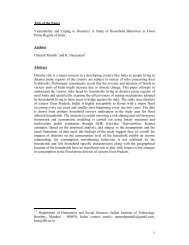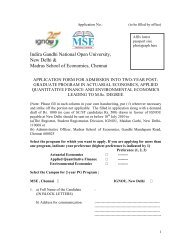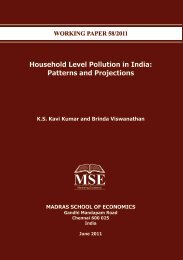Accounting for India's Forest Wealth - Madras School of Economics
Accounting for India's Forest Wealth - Madras School of Economics
Accounting for India's Forest Wealth - Madras School of Economics
- No tags were found...
You also want an ePaper? Increase the reach of your titles
YUMPU automatically turns print PDFs into web optimized ePapers that Google loves.
with mobile firms, Wellisch (1995) shows that direct controls lead toinefficiently low levels <strong>of</strong> emissions, while taxes continue to produce anefficient outcome.Levied on output, it is aimed at raising the price <strong>of</strong> the output,inducing consumers to reduce consumption levels or shift to nonpollutingsubstitutes. Its impact depends on the price-elasticity <strong>of</strong> thepolluting good and availability and relative prices <strong>of</strong> close substitutes.Levied on inputs, any increase in the prices may be partially or fullypassed on to the final goods, depending on the supply and demandelasticities. To the extent that the producers have to bear the burden <strong>of</strong>the price rise, they will explore the option <strong>of</strong> using non-pollutingsubstitutes. Technological innovations reducing the use <strong>of</strong> the pollutinginputs and increasing the use <strong>of</strong> non-polluting substitutes may also beinduced. The environmental tax may be levied directly on the pollutantlike a carbon tax or indirectly on polluting inputs. Administering the taxdirectly on the pollutant is <strong>of</strong>ten costly and difficult to implement andmay sometimes be not consistent with constitutional design <strong>of</strong> taxes.Should these be Revenue-neutral or Revenue-augmenting?The “Double-Dividend” PossibilityIf the environmental taxes are designed to be revenue-neutral, therewould be a corresponding reduction in other conventional taxes. Sincethe conventional taxes are distortionary, deadweight costs <strong>of</strong> taxes canbe reduced. The basic idea <strong>of</strong> the double dividend hypothesis is thatusing environmental tax revenue to reduce the existing distortionarytaxes might be welfare improving regardless <strong>of</strong> the environmental gain(see e.g., Oates, 1991; Pearce, 1991; Bovenberg and de Mooij,1994).Ballard and Medema (1992) argue that conventional taxes that tax labourand capital income are „perverse‟ taxes as they penalise the „goods‟ , viz.,human labour and the successful use <strong>of</strong> capital rather than taxing the„bads‟, viz. the overuse <strong>of</strong> energy and primary resources that lead topollution and consumption <strong>of</strong> exhaustible resources. Weizsacker et al2
around 30 percent in the first period, and would require a carbon tax <strong>of</strong>$56 per tonne.Manresa and Sancho (2005) follow the tradition <strong>of</strong> appliedgeneral equilibrium modelling <strong>of</strong> the Walrasian static variety to study theempirical viability <strong>of</strong> a double dividend (green, welfare, and employment)in the Spanish economy. They consider a counterfactual scenario inwhich an eco-tax is levied on the intermediate and final use <strong>of</strong> energygoods. Under a revenue neutral assumption, they evaluate the realincome and employment impact <strong>of</strong> lowering payroll taxes. They per<strong>for</strong>msimulations under a range <strong>of</strong> alternative model and policy scenarios toassess the extent the model structure and behavioural assumptionsinfluence the results. They conclude that a double dividend (betterenvironmental quality, as measured by reduced CO 2 emissions andimproved levels <strong>of</strong> employment) may be an achievable goal <strong>of</strong> economicpolicy.Sterner (2007) provides a review several studies <strong>for</strong> a number <strong>of</strong>countries and concludes; “Had Europe not followed a policy <strong>of</strong> high fueltaxation but had low U.S. taxes, then fuel demand would have beentwice as large”. Sterner observes that fuel taxes are the single mostpowerful climate policy instrument implemented to date. Environmentaltax re<strong>for</strong>m can have a powerful effect on energy use.Ekins (2009) estimates the price elasticity <strong>of</strong> energy demand inthe UK at about (-) 0.64, which implies that a 10 percent increase in theenergy price will reduce energy consumption by 6.4 percent. He als<strong>of</strong>inds that energy use tends to increase with value added with anelasticity <strong>of</strong> (+) 0.5 (meaning that a 10 percent increase in value addedwill tend to increase energy consumption by 5 percent). Other thingsbeing equal, this means that if a sector (or by implication the economy asa whole) is growing, its energy use will be growing too, unless it isrestrained by a rising energy price.7
With a reasonable change in the relative prices <strong>of</strong> labour andenvironmental resources, environmental tax re<strong>for</strong>m may significantlychange the incentives <strong>for</strong> innovation and technological development,inducing companies to devote more ef<strong>for</strong>t to increasing resourceproductivity, and less to increasing labour productivity. Industries thatreduce pollution, increase resource productivity and encourage a switchto renewable resources. These industries are collectively being called theenvironment industries (EI) which have two distinct components: thesupply <strong>of</strong> traditional pollution control technologies and services („end-<strong>of</strong>pipetreatment‟) and industries relating to resource management(management <strong>of</strong> materials and energy). Both components <strong>of</strong> the EI havecontributed to environmental improvement in the EU.How should Environmental Taxes and Environmental Subsidiesbe Combined?From Curbing Pollution to Promoting EnvironmentOne related question is how revenues from the environmental taxesshould be used. Should these become part <strong>of</strong> the general revenue pool <strong>of</strong>the government or should these be earmarked <strong>for</strong> environmentpromoting activities. By definition, if the environment tax is a cess itshould be earmarked <strong>for</strong> the sector or industry from where it has beenraised. Within that sector it needs to be allocated to promotingenvironment promoting technologies and processes. There are however anumber <strong>of</strong> taxes like taxes on petroleum products and electricity that,while raising revenues <strong>for</strong> the government, also serves to curb a pollutingactivity.3. INDIRECT TAX REFORM IN INDIATowards Taxing the Value-Added: From Central Excise toCENVATThe current generation <strong>of</strong> re<strong>for</strong>ms <strong>of</strong> indirect taxes leading the systemtowards a value added tax started with the introduction <strong>of</strong> MODVAT from8
March 1, 1986 with reference to specified Chapters <strong>of</strong> the Central ExciseTariff Act, 1985. At first, the coverage was limited to 37 out <strong>of</strong> 91Chapters. From March 1, 1987, all commodities except petroleumproducts, textiles, tobacco, cinematographic films and matches werecovered. In the MODVAT system, early in the nineties, full rebate on theexcise tax paid on capital goods was allowed instead <strong>of</strong> setting up asystem <strong>of</strong> annual depreciation related deductions. With effect from 1995-96, the entire manufacturing chain was brought under MODVAT.The central government changed MODVAT to CENVAT in 1996-97. The CENVAT covers value added in the case <strong>of</strong> production and sale <strong>of</strong>goods up to the stage <strong>of</strong> „manufacturing‟. Compared to MODVAT,CENVAT had fewer rates. The taxation space up to the value added inthe production <strong>of</strong> goods is common between the centre and states. Whilethe tax structure was thus simplified, continuation <strong>of</strong> several surchargesand cesses continued to complicate the system. These are listed below:a. Special Excise Duty,b. National Calamity Contingent Duty,c. Education Cess,d. Secondary and Higher Education,e. Cess on Motor Spirit,f. Cess on High Speed Diesel Oil,g. Surcharge on Motor Spirit, andh. Surcharge on Pan Masala and Tobacco Products.Towards Taxing the Value Added: From Sales Tax to State VATState taxes include state sales taxes, the Central Sales Tax (CST)assigned by the central government to the states, motor vehicle tax,state excise duties, entertainment taxes. The structure <strong>of</strong> sales tax, priorto re<strong>for</strong>ms undertaken in late nineties was characterized by high taxrates, multiplicity <strong>of</strong> tax rate and exemptions, lack <strong>of</strong> uni<strong>for</strong>mity indefining the tax base across states, large number incentives, andcascading <strong>of</strong> taxes. During re<strong>for</strong>ms <strong>of</strong> sales taxes prior to the introduction9
<strong>of</strong> state VAT, most states had agreed to phase out the incentive relatedexemptions, and implement floor rates. There are several minor taxesimposed by the States on the sale, purchase, storage and movement <strong>of</strong>different goods.Apart from the general sales tax, most states levied an additionalsales tax or a surcharge. In addition, the states levy luxury tax as also anentry tax on the sale <strong>of</strong> imported goods. All these practices led toheterogeneity in structure, as well as rates, causing diversion <strong>of</strong> trade aswell as shifting <strong>of</strong> manufacturing activity from one state to another.Further, widespread taxation <strong>of</strong> inputs led to vertical integration <strong>of</strong> firms,encouraging production <strong>of</strong> more and more <strong>of</strong> the inputs needed ratherthan purchasing them from ancillary industries. This system taxation <strong>of</strong>goods became non-neutral, interfering with the producers' choice <strong>of</strong>inputs as well as with the consumers' choice <strong>of</strong> consumption, therebyleading to severe economic distortions.With the initiative <strong>of</strong> Empowered Committee <strong>of</strong> the state FinanceMinisters, states initiated indirect tax re<strong>for</strong>ms in the late nineties. As afirst step, they reduced the rate categories in the case <strong>of</strong> sales taxes,reduced exemptions, and introduced floor rates. There were tangiblerevenue benefits after these changes, which facilitated, under theguidance <strong>of</strong> the Empowered Committee, the implementation <strong>of</strong> state levelVAT.The State-VAT recommended by the Empowered Committee <strong>of</strong>state Finance Ministers was elaborated in a White Paper brought out bythe Government <strong>of</strong> India. The main features <strong>of</strong> the scheme suggested bythe Empowered Committee were:a. uni<strong>for</strong>m schedule <strong>of</strong> rates <strong>of</strong> VAT <strong>for</strong> all states, making thesystem simple and uni<strong>for</strong>m and prevent unhealthy taxcompetition among states;10
. the provision <strong>of</strong> input tax credit meant <strong>for</strong> preventing cascadingeffect <strong>of</strong> tax;c. the provision self assessment by dealers aimed at reducingharassment; andd. the zero rating if exports aimed at increasing the competitiveness<strong>of</strong> Indian exports.As per the basic principles <strong>of</strong> VAT, the State-VAT provides that<strong>for</strong> all exports made out <strong>of</strong> the country, tax paid within the state will berefunded in full. Units located in Special Economic Zone (SEZ) and ExportOriented Units (EOUs) are to be granted either exemption from payment<strong>of</strong> input tax.The most important part <strong>of</strong> the VAT scheme relates to the taxrates. Under the VAT system covering about 550 goods, only two basicVAT rates <strong>of</strong> 4 and 12.5 percent are to apply plus a specific category <strong>of</strong>tax-exempted goods and a special VAT rate <strong>of</strong> 1 percent only <strong>for</strong> goldand silver ornaments.Under the exempted category, the Empowered Committee placed46 commodities comprising <strong>of</strong> natural and unprocessed products in theun-organized sector, items that are legally barred from taxation anditems which have social implications. Under the state-VAT, there is theproposal to give flexibility to the states to select a set <strong>of</strong> maximum <strong>of</strong> 10commodities States <strong>for</strong> exemption from a list <strong>of</strong> goods specified by theEmpowered Committee, which are <strong>of</strong> local social importance <strong>for</strong> theindividual States without having any inter-state implications.The rest <strong>of</strong> the commodities in the list are common <strong>for</strong> all theStates. Under 4 percent VAT rate category, the largest number <strong>of</strong> goods(about 270) were placed, common <strong>for</strong> all the States, comprising <strong>of</strong> items<strong>of</strong> basic necessities such as medicines and drugs, all agricultural andindustrial inputs, capital goods and declared goods. The remaining11
commodities, common <strong>for</strong> all the States, will fall under the general VATrate <strong>of</strong> 12.5 percent.It was proposed that VAT on AED items relating to sugar, textileand tobacco, because <strong>of</strong> initial organizational difficulties, will not beimposed <strong>for</strong> one year after the introduction <strong>of</strong> VAT and till then theexisting arrangement will continue.Expanding the Tax Base: Service TaxThe service tax was levied <strong>for</strong> the first time in 1994-95 budget. Sincethen its rate has been progressively increased and the number <strong>of</strong>services under the service tax net has also been increased year after year(Table 1).Table 1: Taxation <strong>of</strong> ServicesService Tax was introduced from 1st July 1994UnionBudgetNumber <strong>of</strong>ServicesIntroducedCumulativeNumber <strong>of</strong>ServicesUnionBudgetNumber <strong>of</strong>ServicesIntroducedCumulativeNumber <strong>of</strong>Services1994-95 3 3 2004-05 7 651996-97 3 6 2005-06 15 801997-98 9 15 2006-07 12 921998-99 11 26 2007-08 6 982001-02 15 41 2008-09 4 1022002-03 10 51 2009-10 4 1062003-04 7 58 2010-11 8 114Source (Basic Data): Union Budgets, various years.Reducing the Tax Rate: Lowering Dependence on Indirect TaxesReducing the tax rates as well as the number <strong>of</strong> rate categories was akey objective <strong>of</strong> the re<strong>for</strong>m. In the case <strong>of</strong> CENVAT, most <strong>of</strong> the productsused to attract excise duties at the rate <strong>of</strong> 14 percent until recently. Asper an announcement in December 2008, the core Cenvat rate has beenbrought down to 10 percent. Some products also attract special exciseduty/and an additional duty <strong>of</strong> excise at the rate <strong>of</strong> 8 percent above the12
Cenvat rate. In addition, there is a 2 percent education and 1 percenthigher education cess applicable on the aggregate <strong>of</strong> the duties <strong>of</strong> excise.Excise duty is levied on ad valorem basis or based on the maximum retailprice in some casesIn 2005, the core Cenvat rate was kept at 16 percent <strong>for</strong> amajority <strong>of</strong> the items. There were two more rates: a demerit rate <strong>of</strong> 24percent and a concessional rate <strong>of</strong> 8 percent. Effectively, there wereseveral other rates <strong>of</strong> excise duty that continue to be applied on differentitems, subject to their end-use. With the 2008-09 budget, the coreCenvat rate was brought down to 14 percent. This has now been broughtdown to 10 percent. The adoption <strong>of</strong> the statevat also led torationalization and some reduction in the tax rates. The rate <strong>of</strong> thecentral sales tax was also gradually brought down.Chart 1: Share <strong>of</strong> Indirect Taxes in Total Tax Revenues90.085.080.075.070.065.060.055.050.01950-511953-541956-571959-601962-631965-661968-691971-721974-751977-781980-811983-841986-871989-901992-93Share <strong>of</strong> indirect taxes in total tax revenue131995-961998-992001-022004-052007-08
Reduction <strong>of</strong> indirect tax rates led to a fall in the share <strong>of</strong> indirecttaxes in total taxes. This was compensated by a rise in the direct taxrevenues so that the overall tax revenue relative to GDP except <strong>for</strong> a fewinitial years <strong>of</strong> re<strong>for</strong>ms did not fall. It may be noted that the ratereduction led to higher tax buoyancy in the case <strong>of</strong> direct taxes and fall intax buoyancy in the case <strong>of</strong> indirect taxes (Appendix Table A2). However,it has reduced the dependence <strong>of</strong> overall tax revenues on indirect taxesthereby facilitating the move to the next stage <strong>of</strong> re<strong>for</strong>ms towards GSTwhere the risk <strong>of</strong> revenue shock to the system is less now than used tobe the case.Unfinished Re<strong>for</strong>msWhile the system <strong>of</strong> taxation is thus characterized by fragmentation andoverlaps in the case <strong>of</strong> goods, the taxation <strong>of</strong> services remains separatedand disjointed. The service tax is levied by the central government.Taxation <strong>of</strong> goods by either tier <strong>of</strong> government may cascade into taxation<strong>of</strong> services and vice versa since goods are needed in the production andsale <strong>of</strong> services and services are needed in the production and sale <strong>of</strong>goods. The nature <strong>of</strong> a modern economy is such that it is <strong>of</strong>ten difficultto draw lines between goods and services as these are embedded intoeach other. Considering the value added <strong>of</strong> goods and services takentogether in the overall Indian economy as providing a comprehensive taxbase, there are three kinds <strong>of</strong> segmentations that take place in Indiaunder the existing arrangements: segmentation <strong>of</strong> goods from services,segmentation <strong>of</strong> central jurisdiction vis-à-vis state jurisdictions, andsegmentation <strong>of</strong> production/manufacture from sale. These artificialdivisions <strong>for</strong> purposes <strong>of</strong> taxation lead to various distortions,administrative and compliance costs, and inefficiencies. These are alsonot consistent with prevailing tax practices in the modern economies <strong>of</strong>the world who have implemented a value added tax regime includingfederal countries.14
Thus, even after the introduction <strong>of</strong> the principle <strong>of</strong> taxation <strong>of</strong>value added in India, its application has remained piecemeal andfragmented. Several problems continue with each segment <strong>of</strong> the system<strong>of</strong> taxation <strong>of</strong> goods and services as summarized below.1. In the case <strong>of</strong> Cenvat, the issues relating to definition <strong>of</strong>manufacturing and methodology <strong>of</strong> valuation remain causingdifficulties in implementation <strong>of</strong> the tax.2. The problem <strong>of</strong> multiple rates remains although the tax ratestructure is simpler than what it used to be. This leads to variousclassification disputes.3. In the case <strong>of</strong> services taxation, problems relate to distinguishingbetween a good and a service. The distinction between the two is<strong>of</strong>ten blurred.4. Exclusion <strong>of</strong> services from the tax base <strong>of</strong> the states potentiallyerodes their tax- buoyancy in a growing economy.5. Cascading has not been fully eliminated as there is cross cascadingbetween Statevat, Cenvat, and central services tax.6. The Central sales tax continues to cause artificial inter-state borderboundaries and violating the destination based principle <strong>of</strong> taxation<strong>of</strong> goods and services.7. Many <strong>of</strong> these problems can be addressed by extending the scope<strong>of</strong> taxation <strong>of</strong> services <strong>for</strong> the states and the scope <strong>of</strong> taxation <strong>of</strong>goods up to the retail stage <strong>for</strong> the centre.This is not to underplay the importance <strong>of</strong> the success alreadyachieved in bringing about a value added taxation mechanism in highlydistorted system <strong>of</strong> taxation in India that existed prior to these re<strong>for</strong>ms.However, the logic <strong>of</strong> re<strong>for</strong>ms would remain incomplete until the goodsand services are integrated <strong>for</strong> purposes <strong>of</strong> taxation <strong>of</strong> the value added inthe process <strong>of</strong> production and sale <strong>of</strong> goods and until a countrywideintegrated market is not created.15
4. THE GST: THREE VERSIONSThe basic idea <strong>of</strong> GST is to adhere closely to the principle <strong>of</strong> acomprehensive value added tax. Three versions <strong>of</strong> GST are currentlyunder Discussion suggested respectively by the Empowered Committee<strong>of</strong> State Finance Ministers, Task Force <strong>of</strong> the Thirteenth FinanceCommission (which we may use as reference point as the 13 FC makesreference to it) and the Model GST <strong>of</strong> the Thirteenth FinanceCommission. In all three cases, the GST has two parts: central GST(CGST) and State GST (SGST). With a view to highlighting the similaritiesand differences between these proposals, we look at the following sixaspects <strong>of</strong> GST proposed by these models. These are: (a) broadstructure, (b) central and state taxes to be merged in GST (c) treatment<strong>of</strong> inter-state sales, (d) rate structure, (e) threshold limits, and (f) place<strong>of</strong> environmental taxes.Broad StructureThe broad structure <strong>of</strong> the GST is similar in all the three models. The GSTconsists <strong>of</strong> a central and state GST components (CGST and SGST) withthe following main features:i. The basic features <strong>of</strong> law such as chargeability, definition <strong>of</strong>taxable event and taxable person, measure <strong>of</strong> levy includingvaluation provisions, basis <strong>of</strong> classification etc. should beuni<strong>for</strong>m across these statutes as far as practicable.ii.The CGST and SGST would be applicable to all transactions <strong>of</strong>goods and services made <strong>for</strong> a consideration except <strong>for</strong> theexempted goods and services, goods which are outside thepurview <strong>of</strong> GST and the transactions which are below theprescribed threshold limits.iii. The CGST and SGST are to be paid to the accounts <strong>of</strong> theCentre and the States separately. Taxes paid against the CGST16
and SGST will get input tax credit (ITC) within the CGST andSGST chains respectively but cross utilization <strong>of</strong> ITC betweenCGST and SGST would not be allowed.iv. The administration <strong>of</strong> the CGST will be with the centre and that<strong>of</strong> SGST with the States.v. The GST is based on the destination principle. This requiresthat inter-state sales <strong>of</strong> goods and services and exports arezero-rated.Taxes to be MergedThere are however differences about the taxes to be merged. Table 2highlights these.The most comprehensive list has been proposed by the TaskForce. Between the 13 th FC and its Task Force, the inclusion <strong>of</strong> residentialand commercial property is the additional inclusion in the latter. In theEmpowered Committee list, compared to that <strong>of</strong> the 13 th FC, thefollowing are the main exclusions: stamp duty, tax on vehicles, purchasetax, and electricity duty. There is a difference in the way reference ismade to the entry tax. In the EC case, it covers entry tax in lieu <strong>of</strong> octroi.In the case <strong>of</strong> the 13 th FC, it refers to entry tax in lieu <strong>of</strong> octroi orotherwise. These differences have a bearing on the determination <strong>of</strong> therevenue-neutral rate.17
Table 2: Central and State Taxes to be Merged into GSTEmpowered Committee Task Force (13 th FC) 13th FinanceCommissionCentral Taxes(i) Central Excise Duty, (ii)Additional Excise Duties, (iii)Excise Duty levied under theMedicinal and ToiletriesPreparation Act, (iv) ServiceTax, (v) Additional CustomsDuty, commonly known asCountervailing Duty (CVD),(vi) Special Additional Duty<strong>of</strong> Customs (SAD), (vii)Surcharges, and (viii)Cesses.State Taxes(i) VAT / sales tax, (ii)entertainment tax (unless itis levied by the local bodies,(iii) luxury tax, (iv) taxes onlottery, betting andgambling, (v) State cessesand surcharges in so far asthey relate to supply <strong>of</strong>goods and services, and (vi)entry tax not in lieu <strong>of</strong>Octroi.Central Excise Duty(including Additional ExciseDuties);Service Tax;Additional Customs Duty(commonly referred to as„CVD‟); andSurcharges and all cessesVAT/Sales Tax (includingcentral sales tax andpurchase tax);Entertainment tax (otherthan levied by local bodies);Entry taxes not in lieu <strong>of</strong>Octroi;Other Taxes and Duties(includes luxury tax, taxeson lottery, betting andgambling, and all cessesand surcharges by States);Stamp duty;Taxes on Vehicles;Taxes on Goods andPassengers; andTaxes and duties onelectricity.Residential and commercialpropertyCentral excise duty andadditional excise dutiesService TaxAdditional Customs Duty(Countervailing Duty )All surcharges and cessesValue Added TaxCentral Sales TaxEntry Tax, whether in lieu <strong>of</strong>octroi or otherwiseLuxury TaxTaxes on lottery, betting andgamblingEntertainment TaxPurchase TaxState Excise DutiesStamp DutyTaxes on vehiclesTax on goods andpassengersTaxes and duties onelectricityAll state cesses andsurcharges18
Inter-state TransactionsIn the Empowered Committee model, the Centre would levy IntegratedGoods and Services Tax (IGST) which would be CGST plus SGST on allinter-State transactions <strong>of</strong> taxable goods and services with appropriateprovision <strong>for</strong> consignment or stock transfer <strong>of</strong> goods and services. Theinter-State seller will pay IGST on value addition after adjusting availablecredit <strong>of</strong> IGST, CGST, and SGST on purchases. The exporting state willtransfer to the Centre the credit <strong>of</strong> SGST used in payment <strong>of</strong> IGST. Theimporting dealer will claim credit <strong>of</strong> IGST while discharging his output taxliability in his own State. The Centre will transfer to the importing Statethe credit <strong>of</strong> IGST used in payment <strong>of</strong> SGST. The relevant in<strong>for</strong>mation willalso be submitted to the Central Agency which will act as a clearinghouse mechanism, verify the claims and in<strong>for</strong>m the respectivegovernments to transfer the funds. Table 3 shows the mechanism <strong>of</strong>handling inter-state transactions by Empowered Committee, Task Forceand the Thirteenth Finance Commission.Instead <strong>of</strong> IGST, the Task Force recommends adoption <strong>of</strong> aModified Bank Model (the Bank Model was referred to in the EC DraftDiscussion Paper) and suggests that all inter-state transactions in goodsand services should be effectively zero rated by adopting the ModifiedBank Model. The consignment sales and branch transfers across statesshould be subject to treatment in the same manner as if it was a interstatetransaction in the nature <strong>of</strong> sale between two independent dealers.The Thirteenth Finance Commission has not specified any specificmechanism. Any model can be adopted which will satisfy the condition <strong>of</strong>zero rating <strong>of</strong> inter-state transactions and exports.19
Table 3: Mechanism <strong>of</strong> handling Inter-State TransactionsEmpoweredCommitteeIntegrated GST (IGST)Centre to levy IGSTwhich would be CGSTplus SGST on all inter-State transactions <strong>of</strong>taxable goods andservices with appropriateprovision <strong>for</strong>consignment or stocktransfer <strong>of</strong> goods andservices.Centre to transfer to theimporting State the credit<strong>of</strong> IGST used in payment<strong>of</strong> SGST.Task Force (13 th FC)Modified Bank modelAll inter-statetransactions in goodsand services to be zerorated using the ModifiedBank Model. Theconsignment sales andbranch transfer shouldbe similarly treated.13th FinanceCommissionAny model meeting thecondition <strong>of</strong> zero-rating<strong>of</strong> export can beconsidered.Threshold LimitsKeeping in view the compliance cost and administrative feasibility, smalldealers (including service providers) and manufacturers should beexempted from the purview <strong>of</strong> both CGST and SGST if their annualaggregate turnover (excluding both CGST and SGST) <strong>of</strong> all goods andservices does not exceed Rs.10 lakh. However, like in most othercountries, those below the threshold limit may be allowed to registervoluntarily to facilitate sales to other registered manufacturers/dealers,limit competitive distortions and avoid inequities. Further, the thresholdexemption limit should be uni<strong>for</strong>m <strong>for</strong> both CGST and SGST and acrossStates. With a view to reducing administrative and compliance burden,small dealers with annual aggregate turnover <strong>of</strong> goods and servicesbetween Rs.10 lakh to Rs.40 lakh may be allowed to opt <strong>for</strong> acompounded levy <strong>of</strong> one percent, each towards CGST and SGST.However, no input credit should be allowed against the compounded levyor purchases made from exempt dealers (Table 4).20
Table 4: Threshold LimitsEmpoweredCommitteeSGST: Gross annualturnover <strong>of</strong> Rs.10 lakhboth <strong>for</strong> goods andservices <strong>for</strong> all the Statesand Union TerritoriesCGST:Separate thresholds <strong>for</strong>goods and servicesGoods: Rs.1.5 crore andthe Services: Rs. 10 lakh.Task Force (13 th FC)Threshold: Annualaggregate turnover(excluding both CGSTand SGST) not to exceedRs.10 lakh.Those below thethreshold limit mayregister voluntarilyThreshold exemptionlimit should be uni<strong>for</strong>m<strong>for</strong> both CGST and SGSTand across States.Small dealers withannual aggregateturnover <strong>of</strong> goods andservices between Rs.10lakh to Rs.40 lakh mayopt <strong>for</strong> a compoundedlevy <strong>of</strong> one percent.13th FinanceCommissionA threshold <strong>of</strong> Rs. 10lakh and a compositionlimit <strong>of</strong> Rs. 40 lakhSales <strong>of</strong> goods <strong>of</strong> localimportance will fall withinthese threshold limits,thus keeping them out <strong>of</strong>the ambit <strong>of</strong> GST.The Empowered committee considers separate thresholds <strong>for</strong>goods and services and <strong>for</strong> SGST and CGST. The Task Force and theThirteenth Finance Commission go <strong>for</strong> a uni<strong>for</strong>m threshold. The ECconsiders gross annual turnover whereas the Task Force refers toturnover net <strong>of</strong> CGST and SGST.Exemption ListsThe Task Force suggests that the Centre and the States should draw up acommon exemption list which should be restricted to the following:21
i. All public services <strong>of</strong> Government (Central, State andii.municipal/panchayati raj) including civil administration, healthservices and <strong>for</strong>mal education services provided by governmentschools and colleges, defence, para-military, police, intelligence andgovernment departments. However, public services should notinclude railways, post and telegraph, other commercial departments,public sector enterprises, banks and insurance, health and educationservices;Any service transactions between an employer and employee eitheras a service provider, recipient or vice versa;iii. any unprocessed food article which is covered under the publicdistribution system should be exempt regardless <strong>of</strong> the outletthrough which it is sold;iv. education services provided by non-governmental schools andcolleges; andv. health services provided by non-governmental agencies.vi. The Thirteenth Finance Commission follows a similar approach andobserves that no exemptions should be allowed other than acommon list applicable to all states as well as the Centre, whichshould only comprise: (i) unprocessed food items; (ii) public servicesprovided by all governments excluding railways, communicationsand public sector enterprises and (iii) service transactions betweenan employer and employee (iv) health and education services. Italso says that the present area-based exemption schemes should beterminated. The existing schemes should not be grandfathered.Alternative options like refunding taxes paid by industries in theselocations could be considered.Determining the Overall Rate and Central and State ComponentsAn important issue is to determine a suitable GST rate. At present goodsare taxed at the core rate <strong>of</strong> Cenvat at 10 percent and core State VAT <strong>of</strong>12.5 percent. This together would be very high although it would be less22
than 22.5 percent as the 10 percent rate applies to value added only upto the manufacturing stage and the GST will have a larger base. Theservice tax rate is 10 percent. The highest GST rates are in Sweden andDenmark at 25 percent. At the lower end, Switzerland, Japan, Thailandand Singapore have GST/VAT rates at 5 percent or marginally above.The Task Force and the 13 th FC suggest an overall rate <strong>of</strong> 12percent. The EC has not indicated the overall GST rate. The A relatedissue relates to decomposing the overall GST rate into its central andstate components making sure that the relative pre-transfer revenuelevels are not disturbed. The Kelkar Committee had suggested a division<strong>of</strong> the overall rate <strong>of</strong> 20 percent into 12:8 ratio in favor the centre. Thismay need to be reexamined with current levels <strong>of</strong> revenues under Cenvatand service taxes and the Statevat and other related taxes that may besubsumed in the GST (Appendix Table A1).the three models is shown in Table 5.GST rate structure as perTable 5: GST Rate StructureEmpoweredCommitteeSGSTFor Goods2 Rate StructureLower rate: 4-5 percentCore rate: 8-10 percentServices: one rate8-10 percentTask Force (13 th FC)CGST: 5 percentSGST: 7 percent13th FinanceCommissionCGST: 5 percentSGST: 7 percentStated as the target.In a recent study Kavita Rao and Pinaki Chakraborty (2008)estimate the revenue neutral GST rate using two methods, namely, aGDP based method and a consumption expenditure based method.Following the GDP–based method she estimates the revenue neutral GSTrate to be about 14 with a 10 percent rate <strong>of</strong> non-rebatable excises onpassenger cars and multi-utility vehicles, petroleum products, and23
tobacco products. Following the consumption expenditure method sheobserves that the rate <strong>of</strong> GST required <strong>for</strong> revenue neutrality would be20 percent. With improved tax administration, the GST rate can bereduced further.The Task Force <strong>of</strong> the Thirteenth Finance Commission hasestimated with reference to a comprehensive tax base (as discussed inthis chapter) a revenue neutral rate <strong>of</strong> 12 percent, with 5 percent <strong>for</strong> thecentre, and 7 percent <strong>for</strong> the states.Overtime the relative share <strong>of</strong> the GST components <strong>for</strong> thecentre and the states have been changing marginally away from thecentre due to the erosion <strong>of</strong> buoyancy <strong>of</strong> Union excise duties (seeAppendix Table A2).The Task Force has recommended a single positive rate, each <strong>for</strong>CGST and SGST on all goods and services. In addition, there should be azero rate applicable to all goods and services exported out <strong>of</strong> the country.The Task Force favours a single rate structure GST and someinternational experience with VAT in support. States have said that asingle rate <strong>of</strong> State GST <strong>for</strong> all goods and services will be highlyregressive in India with its large low income population. It is mainly thearticles <strong>of</strong> common consumption which are in the lower rate bands <strong>of</strong>VAT. The single revenue-neutral rate will definitely be much higher thanthe rate now prevailing at the lower bands. To deal with problem, theTask Force suggests a moderate threshold exemption level <strong>for</strong>registration <strong>of</strong> dealers. Consequently, all small dealers would remainoutside the purview <strong>of</strong> the GST. The Task Force Report argues that thetax incidence on products sold through such dealers would be relativelylower. Since the poorer section <strong>of</strong> the society tend to make theirpurchases from such small and unregistered dealers, the consumption <strong>of</strong>any commodity by the poor would bear a relatively lower incidence <strong>of</strong> tax24
than the consumption <strong>of</strong> the same commodity by the relatively richersection <strong>of</strong> the society.The Task Force has used the fiscal year 2007-08 as the baseyear <strong>for</strong> calculation <strong>of</strong> the revenue neutral rate (RNR). For the purposes<strong>of</strong> estimation <strong>of</strong> the GST base, the Task Force used several alternativeapproaches and estimated the GST base under these methods. Thevarious estimates <strong>of</strong> the GST Base <strong>for</strong> 2007-08 are summarized in Table3. Since the five estimates are different, the Task Force adopts theiraverage <strong>of</strong> Rs. 3125325 crore, as the size <strong>of</strong> the comprehensive GSTbase <strong>for</strong> 2007-08 <strong>for</strong> the purposes <strong>of</strong> estimating the RNR. Since the taxbase <strong>for</strong> both the CGST and the SGST are proposed to be identical, theTask Force uses the same tax base <strong>for</strong> calculating the RNR <strong>for</strong> bothlevies.The Task Force estimated the RNR <strong>for</strong> the CGST at 5.0 percent.Similarly, the RNR in respect <strong>of</strong> the state level taxes which are proposedto be subsumed in the SGST is estimated to be 7.0 percent. Thecombined RNR is estimated to be 12 percent. The Task Force alsorecommended the abolition <strong>of</strong> all entry and Octroi taxes by stategovernments and other sub-national governments.Thus, there are clear differences in the GST rate and its structurebetween what the Empowered Committee is considering and what hasbeen proposed by the Thirteenth Finance Commission and also it‟s TaskForce. These differences arise because <strong>of</strong> the coverage <strong>of</strong> goods andtheir exemption considered by the Empowered Committee compare tothe other two models.Environmental/Demerit GoodsThe 13 th FC Task Force considers the power sector is to be an integralpart <strong>of</strong> the comprehensive GST. The tax regime <strong>for</strong> the power sectorshould be the same as in the case <strong>of</strong> any other normal good. The25
electricity duty levied by the States should be subsumed in the SGST.Table 6 shows the provision <strong>for</strong> environmental taxes/ Demerit goods bythe Empowered Committee, Task Force and the Thirteenth FinanceCommission.The tax on vehicles and the tax on goods and passengers leviedby the State Governments should also be subsumed in the GST. Alltransport equipments and all <strong>for</strong>ms <strong>of</strong> services <strong>for</strong> transportation <strong>of</strong>goods and services by railways, air, road and sea must <strong>for</strong>m an integralpart <strong>of</strong> the comprehensive GST base recommended by the Task Forceover which both the Central and State Governments would haveconcurrent jurisdiction. The tax regime <strong>for</strong> the transport equipments andtransport services should be the same as in the case <strong>of</strong> any other normalgoods.The Task Force refers to the demerit goods as sin goods. The singoods are listed as emission fuels, tobacco products and alcohol, whichshould be subject to a dual levy <strong>of</strong> GST and excise. No input credit shouldbe allowed <strong>for</strong> this excise duty. However, industrial fuels should besubjected only to GST (both Central and State) with the benefit <strong>of</strong> inputcredit like any other intermediate good.26
Table 6: Provision <strong>for</strong> Environmental Taxes/Demerit GoodsEmpoweredCommitteeTaxation <strong>of</strong> PetroleumProductsCrude, motor spirit(including ATF) andHSD would be keptoutside GST Sales Taxcould continue to belevied by the States onthese products withprevailing floor rate.Centre could alsocontinue its levies.On Natural Gas a finalview has not beentaken yet.Sales Tax/VAT tocontinue on alcoholicbeveragesIn case it has beenmade Vatable by someStates, this maycontinue.Tobacco products wouldbe subjected to GSTwith ITC. Centre maybe allowed to levyexcise duty on tobaccoproducts over andabove GST without ITC.Task Force (13 th FC)The sin goods are listed asemission fuels, tobaccoproducts and alcohol,which should be subject toa dual levy <strong>of</strong> GST andexcise. No input creditshould be allowed <strong>for</strong> thisexcise duty. However,industrial fuels should besubjected only to GST(both Central and State)with the benefit <strong>of</strong> inputcredit like any otherintermediate good.tax/fee/charge/cess whichis essentially in the nature<strong>of</strong> a user charge <strong>for</strong> supply<strong>of</strong> goods and services(includingenvironmental goodsand services) also shouldnot be subsumed underthe CGST or SGST.Further, both Centre andthe States should takesteps to consolidate alltaxes (other than proposedGST) on the sin goods as asingle levy termed asCentral Excises andState Excises,respectively.13th FinanceCommissionHSD, MS, and ATF couldbe charged GST and anadditional levy byboth the Central andState Governments. Noinput credit would beavailable against eitherCGST or SGST on theadditional levy.A similar treatmentwould be provided toalcohol and tobacco.Such an arrangement totake care <strong>of</strong>environmental concerns.27
Any amount collected through these taxes on the SIN goodsshould not be subsumed either in the CGST or the SGST. Similarly anyamount which is collected as tax/fee/charge/cess which is essentially inthe nature <strong>of</strong> a user charge <strong>for</strong> supply <strong>of</strong> goods and services (includingenvironmental goods and services) also should not be subsumed underthe CGST or SGST. Further, both Centre and the States should take stepsto consolidate all taxes (other than proposed GST) on the sin goods as asingle levy termed as Central Excises and State Excises, respectively. Allentry and Octroi duties levied by the third-tier <strong>of</strong> Government must beabolished.Thus, the Task Force on GST set up by the 13 thFinanceCommission recognized the issue <strong>of</strong> negative externalities in a clearerway and collectively refers to these as sin goods and services and makesa distinction between sin goods and non-sin goods. The Task Forcedefines sin goods as goods whose consumption create negativeexternalities and <strong>for</strong> the purposes <strong>of</strong> their Report it, collectively orseverally, refers to emission fuels, tobacco goods and alcohol. It observesthat emission fuels generate negative externalities, whose consumptionneeds to be checked. It notes that generally, goods with negativeexternalities should be subjected to excise duties in respect <strong>of</strong> whichinput tax credit is not allowed.The Thirteenth Finance Commission has suggested that thetaxation <strong>of</strong> petroleum products and natural gas would be rationalised byincluding them in the tax base. HSD, MS, and ATF could be charged GSTand an additional levy by both the Central and State Governments. Noinput credit would be available against either CGST or SGST on theadditional levy. A similar treatment would be provided to alcohol andtobacco. Such an arrangement would ensure protection <strong>of</strong> existingrevenues while taking care <strong>of</strong> environmental concerns.28
5. INTERNATIONAL EXPERIENCE WITH ENVIRONMENTAL TAXESEnvironmental tax re<strong>for</strong>m in different countries across the world mainlyaim at shifting the tax burden from factors <strong>of</strong> production, such as labourand capital, to pollution and the use <strong>of</strong> natural resources (EC, 1997).Elements <strong>of</strong> Strategic tax re<strong>for</strong>m generally involve three complementaryactivities (EEA, 1996; OECD, 1997): (a) removal <strong>of</strong> existing taxes andsubsidies that have negative environmental impacts; (b) restructuring <strong>of</strong>existing taxes in an environmentally friendly manner; and (c) introducingnew environmental taxes.The international with green taxes indicates that while the initialemphasis was on energy and transport, the tax bases <strong>for</strong> theenvironmental taxes have expanded over time. Apart from the fuel taxesthat are levied in all countries in Europe, other taxes include waste endtaxes (in Austria, Finland, France, Greece, Italy, Sweden, Norway andUK), packaging (in Italy), solvents (Denmark and Norway), PVC/phthalates (Denmark), and annual car taxes differentiated according toenvironmental characteristics (Germany) (EEA, 2000). Table 7 provides asummary <strong>of</strong> the environmental effectiveness <strong>of</strong> the green shift in taxationacross various countries. International experience has shown thatenvironmental taxes can be quite effective in their environmental impact.Many countries have undertaken <strong>for</strong>mal or in<strong>for</strong>mal reductiontargets <strong>for</strong> greenhouse gases emissions. With the Climate Change Act,the UK Government has now legislated into statute the commitment toreduce the greenhouse gases emissions (GHGs) by 80 percent from 1990levels by 2050. This will require comparable reductions in emissions <strong>of</strong>carbon dioxide, the principal greenhouse gas, which are mainly the result<strong>of</strong> burning fossil fuels. The Climate Change Committee has recommendedthat to meet this, the UK should reduce its GHG emissions by a minimum<strong>of</strong> 34 percent from 1990 levels by 2020. Most <strong>of</strong> the reductions by 2020will have to come from the large-scale deployment <strong>of</strong> new renewablestechnologies.29
Table 7: Impact <strong>of</strong> the Green Shift in Taxation: SelectedInternational EvidenceCountry andTaxFinland -energy andcarbon taxNorway -carbon andsulphurdioxide taxesDenmark -energy andcarbon taxSwedenenergy&carbon taxesTheNetherlandsenergytaxGermanyenvironmentaltax re<strong>for</strong>m,taxes ontransport,fuels&electricityUK-Industrialenergy taxPeriod ImpactEvaluated1990-2005 CO 2 emissions 7 percent lower than would haveotherwise beenA shift from carbon tax to output tax on electricity in1997 may have lessened impact1991-2007 21 percent reduction in CO 2 from power plants by199514 percent national reduction in CO 2 in 1990's, 2percent attributed to carbon tax12 percent reduction in CO 2 emissions per unit <strong>of</strong>GDP1992 CO 2 emissions in affected sectors down by 6 percentand economic growth up by 20 percent between1988 and 1997 and a 5 percent reduction inemission in one year in response to tax increaseIn 1990s a 23 percent reduction in CO 2 from asusual trend and energy efficiency increased by 26percentSubsidy to renewables may have accounted <strong>for</strong>greater proportion <strong>of</strong> emissions reductions than tax1990-2007 Emissions reductions <strong>of</strong> 0.5 million tons per annumEmissions would have been 20 percent higher than1990 levels without tax1999-2007 Emissions 3.5 percent lower than would haveotherwise beenLow tax rates may have limited impact1999-2005 CO 2 reduced by 15 percent between 1990 and 1999and 1 percent between 1999 and 2005CO 2 emissions 2-3 percent lower by 2005 than theywould have been without taxGerman re-unification an important factor inreductions2001-2010 UK CO 2 emissions reduced by 2 percent in 2002 and2.25 percent in 2003 and cumulative savings <strong>of</strong> 16.5million tonnes <strong>of</strong> carbon up to 2005Reduction in UK energy demand <strong>of</strong> 2.9 percentestimated by 2010Source: Green Fiscal Commission (2009).SourceNordiccouncil 2006NordicCouncil 1999OECD 2001OECD 2006Nordiccouncil 2006OECD 2006NordicCouncil 2006Nordiccouncil 2006SwedishMinistry <strong>of</strong>Finance2004Financeministry, theNetherlands2007EEA 2007OECD 2006CambridgeEconometrics2005HMT 200630
Increasing the price <strong>of</strong> energy is considered to be criticalintervention <strong>for</strong> achieving the GHG emissions reduction targetsinternationally. Increased energy efficiency through higher investment inrenewables and reduced demand <strong>for</strong> energy services will also help Indiaachieve the emission reduction target <strong>for</strong> which a commitment has beenmade.In the past there have been two sources <strong>of</strong> energy priceincreases: from markets, as (<strong>for</strong> example) the oil price increases in 1973and 1979, and more recently in 2007-08; and from government policy,mainly from taxation such as fuel duty or the Climate Change Levy in theUK. Both these taxes have reduced fuel use below what they wouldotherwise have been, although in the case <strong>of</strong> fuel duty even a relativelyhigh rate <strong>of</strong> duty has not been enough to actually reduce the use <strong>of</strong>transport fuels. In Germany however, a 90 percent increase in dieselprices and 62 percent increase in petrol prices over 1997-2006, largelydriven by increases in taxation, caused the total consumption <strong>of</strong> the mainroad fuels to decrease by 13 percent.But price increases by government keep revenues in the countryand generate tax receipts which allow other taxes to be reduced. There isa very important economic difference between market-driven andtaxation-driven increases in energy prices. In the case <strong>of</strong> the <strong>for</strong>mer theextra revenues accrue to energy companies and energy-producingcountries, at the expense <strong>of</strong> energy-consuming countries. With the latterthe government <strong>of</strong> the energy-consuming country keeps the revenuesfrom the price increase, which, <strong>for</strong> a given level <strong>of</strong> governmentexpenditure, allows it to reduce other taxes, with greatly reducednegative impacts on its economy.Another important difference is that market-driven increases in,<strong>for</strong> example, oil prices will stimulate investment into high-carbonsubstitutes <strong>for</strong> crude oil (e.g. oil shale and tar sands - as indeed has31
happened with the relatively high oil prices over 2006-08) as well as intolow-carbon energy sources. Government taxation, in contrast, can targetcarbon emissions through a carbon tax, which would penalize highcarbonoil substitutes and be far more effective in promoting newinvestment into low-carbon energy sources.There are important lessons <strong>for</strong> India from the internationalexperience. First, the tax on energy should be allowed to continue tocascade and polluting goods and services should be differentially taxed athigher rate. Further, India should develop capacity in environmentindustries where there is the potential <strong>of</strong> considerable growth <strong>of</strong> demandrather than concentrating on polluting industries where already there isconsiderable excess capacity globally.6. INTEGRATING ENVIRONMENTAL TAXES INTO GST DESIGNThree Forms <strong>of</strong> Environmental Taxes in GST FrameworkLooking at the three versions <strong>of</strong> the GST, it appears that three routes <strong>for</strong>the environmental taxes can be part <strong>of</strong> the overall scheme <strong>of</strong> indirecttaxes in India the core <strong>of</strong> which can be the GST. These are: nonrebatableexcise duties by the centre and the states on selected pollutingproducts, environmental cesses where a link can be established betweenthe revenue from the cess and the environmental promoting activity, anduser charges. In addition, at the local government level environmentaltaxes like the congestion charges can be levied. The most important <strong>of</strong>these will be the non-rebatable excises and the selection <strong>of</strong> goods thatcan be placed under these. The 13 th Finance Commission has madereference to all <strong>of</strong> these but the coverage <strong>of</strong> goods <strong>for</strong> non-rebatableexcises is limited to petroleum products, alcoholic beverages, andtobacco. The mention regarding cesses is about cesses <strong>for</strong> emergencyconditions. In other places, the Commission says that all cesses should32
e merged. The Task Force asks <strong>for</strong> subjecting all environmentalpolluting goods to a non-rebatable excise.Taxation <strong>of</strong> Petroleum ProductsTaxation <strong>of</strong> petroleum products will be a key component <strong>of</strong> the taxes thatcan serve an environmental objective. The 2009-10 Union Budget has notonly restored the earlier customs duty rate and excise duty rate but alsogiven the signal that the government will move towards de-administeringthe pricing regime and making all subsidies transparent. In this regards,the three GST models discussed above have different propositions. TheEmpowered Committee model keeps taxation <strong>of</strong> petroleum out <strong>of</strong> theGST framework while the other two make a distinction between emissionfuels and others. The first step in rationalizing the scheme is to establisha clear distinction between international/ producer‟s price <strong>of</strong> petroleumproducts, subsidy elements if any, and the overall tax component withand without cascading. The second step is to take into account anyincrease in the tax component and consequent increase in the taxrevenues to reduce fully or partially the core GST rate. Internationalevidence indicates that Indian retail prices <strong>of</strong> petroleum products aresome where around the average and not the highest. The same appliesto other demerit goods like alcohol and tobacco.Coverage <strong>of</strong> Other Polluting GoodsA select number <strong>of</strong> other polluting goods should be subjected to either anon-rebatable excise over and above the GST or a cess. When a cess islevied, the revenue should be earmarked <strong>for</strong> the same industry <strong>for</strong>environmental promoting activities. It may be noted that in the GST,effective tax rate <strong>of</strong> some <strong>of</strong> the polluting goods are bound to comedown compared to present tax rates, central and state rates takentogether. This is bound to encourage pollution. This needs to becorrected in moving to GST by a non-rebatable excise or cess.33
Table 8 indicates that many <strong>of</strong> the polluting good suffered ahigher indirect tax rate in 2006-07. By that time many states hadaccepted and implemented Statevat. Only a few states implemented itafter 2006-07. Clearly, a lowering <strong>of</strong> the GST rate from these high levelswould encourage greater used <strong>of</strong> the polluting goods. The ThirteenthFinance Commission based on the NCAER report has observed that themove to GST will have positive environmental outcomes. This is basemainly on estimated lower energy consumption while growth takes place.Since the NCAER report uses 2003-04 input-output coefficient matrixesand since these coefficients remain fixed any substitution effects induceby lowering <strong>of</strong> effective tax rate on the polluting goods are not captured.On the aspect <strong>of</strong> energy intensity <strong>of</strong> growth both international and Indiaexperience indicates that with technological improvement energyintensity has been going down. GST has no direct bearing on it.34
Table 8: Effective Tax Rates <strong>for</strong> Selected PollutingGoods/IndustriesIndirect Taxes Net <strong>of</strong> Subsidies as percentage <strong>of</strong> Gross Value Added2003-04 2006-07 2003-04 2006-07Electrical industrial112.8 81.8 Fertilizers 24.7 28.1machineryBatteries 81.8 61.9 Motor cycles and30.0 27.5scootersElectrical wires & cables 73.6 59.5 Soaps, cosmetics & 22.7 26.4glycerinPetroleum products 31.9 56.9 Drugs and medicines 23.3 25.0Iron and steel foundries 52.0 56.7 Non-ferrous basic 32.0 24.1metalsElectrical appliances 70.0 56.2 Other chemicals 23.3 23.7Plastic products 42.9 39.8 Pesticides 20.1 23.4Iron and steel casting &<strong>for</strong>gingPaints, varnishes andlacquers35.5 35.0 Coal tar products 24.3 21.630.3 34.4 Printing andpublishing21.3 19.4Motor vehicles 37.0 34.1 Iron, steel and ferro 9.1 17.1alloysSynthetic fibers, resin 28.1 32.7 Leather and leather 8.2 17.0productsInorganic heavy chemicals 29.9 31.5 Cotton textiles 10.1 10.1Paper, paper prods. &35.3 31.4 Cement 12.5 9.9newsprintOrganic heavy chemicals 28.8 30.8 Electricity -31.5 -20.3Notes: 1. 2003-04 rates are based on commodity by commodity matrix2. 2006-07 rates are based on commodity by industry matrix3. Negative value means that the good/industry is net subsidized.Source: Based on Input-Output Tables <strong>of</strong> India, CSO.Taxation <strong>of</strong> CoalA key component <strong>of</strong> the environmental taxes will have to relate totaxation <strong>of</strong> coal. In the Union Budget <strong>of</strong> 2010-11, <strong>for</strong> the first time thecentral government has taken the initiative <strong>of</strong> levying a cess <strong>of</strong> Rs. 50 per35
tonne on domestically produced and imported coal. The revenue <strong>of</strong> thiscess will <strong>for</strong>m the resource pool <strong>for</strong> a „clean coal fund‟.Other State and Local TaxesIn addition to the GST there would be other state and local taxes whichmay be used to serve as environmental purpose. Congestion taxes andpreferential treatment to green properties in the case <strong>of</strong> property tax aretwo examples.Pricing <strong>of</strong> Polluting GoodsThe effect <strong>of</strong> environmental taxes are <strong>of</strong>ten negated and almost alwaysdifficult to work out when important polluting goods like petroleum, coal,and fertilizers are characterized by administered pricing regimes and nontransparentsubsidies. Market-determined prices and transparent subsidyregime is a necessary condition <strong>for</strong> working out an effective design <strong>of</strong>environmental taxes.Complementary SubsidiesApart from subsidies that may be linked to cesses, environmentpromoting subsidies should also be drawn from the general budget. TheUnion Budget <strong>of</strong> 2010-11 has taken several initiatives in their directionsincluding support <strong>for</strong> installing a zero liquid discharge system as Thirupurin Tamil Nadu and support <strong>for</strong> National Ganga River Basin Authority.Similarly, the Thirteenth Finance Commission has recommended threespecific grants <strong>for</strong> promoting environment in addition to various statespecific grants. These grants are aimed at increasing the <strong>for</strong>est cover inIndia promoting connectivity <strong>of</strong> renewable energy to National grid andbetter management <strong>of</strong> water resources. At the same time, many <strong>of</strong> theenvironmentally perverse subsidies like those <strong>for</strong> fertilizers need to becurbed.36
The main reason <strong>for</strong> resisting environmental fiscal re<strong>for</strong>ms is theperception that it would slow down growth. Growth is energy-intensiveand environmental taxes make energy costlier. However, manyinternational studies (see, Ekins, 2009 <strong>for</strong> a perspective) have shown theeffect <strong>of</strong> environmental tax re<strong>for</strong>m with the green shift may havenegligible adverse effect on growth and positive effect on employment.The Central Ministry <strong>of</strong> Power (2007) notes that in the high growthperiod <strong>of</strong> 2004-08, an economic growth rate <strong>of</strong> over 9 percent perannum, which has been achieved with an energy growth <strong>of</strong> less than 4percent per annum. With subsidy interventions, a steady reduction in theenergy-intensity <strong>of</strong> growth can be achieved over and above the trend inorder to meet India‟s self-commitment <strong>of</strong> reducing the carbon-intensityby 20-25 percent by 2020.7. CONCLUDING OBSERVATIONSIn this paper we have highlighted that inspite <strong>of</strong> ef<strong>for</strong>ts <strong>for</strong> re<strong>for</strong>mingindirect taxes in India over a period <strong>of</strong> two decades, the system remainshighly segmented where cascading continues between Statevat andCenvat, and between taxation <strong>of</strong> goods and services. Inter-state barriers<strong>of</strong> trade also continue because <strong>of</strong> the central sale tax. Although taxation<strong>of</strong> petroleum products at high rates serves an environmental purposealso pricing and taxation in this sector suffers from considerable nontransparency.Coal and coal products have also been taxed at relativelylower rates. A systematic policy <strong>for</strong> many indirect taxes <strong>for</strong> curbingpollution and promoting environment has not been put in place.The<strong>for</strong>thcoming introduction <strong>of</strong> GST provides the relevant context were theoverall design <strong>of</strong> GST should incorporate the environmental taxes with aview to imparting a green shift to India‟s tax system in line withcomparable international experience. Although there are considerabledifferences among the three models <strong>of</strong> GST that are currently underdiscussion viz., the model proposed by the Empowered Committee <strong>of</strong> the37
State Finance Ministers, The Task Force <strong>of</strong> Thirteenth FinanceCommission and the model GST recommended by the Thirteenth FinanceCommission, in all cases there is a clear recognition <strong>of</strong> the need <strong>for</strong>environmental taxes, an reference has been made to demerit goods/singoods/environment (polluting) goods.The Thirteenth Finance Commission has made reference to three<strong>for</strong>ms <strong>of</strong> environmental taxes” Non-rebatable excise duties, cesses, anduser charges. These three <strong>for</strong>ms <strong>of</strong> environmental taxes can be used toserve different purposes. Non-rebatable excises add to overall GST level,and this should be used to at least partially reduce the core GST rate.Cesses should be earmarked <strong>for</strong> environment promoting activities inindustries to cover cost <strong>of</strong> specific publically provided environmentalservices were beneficiaries are identifiable..REFERENCESBallard, C. L and S.G. Medema (1992), The Marginal Efficiency Effects <strong>of</strong>Taxes and Subsidies in the Present <strong>of</strong> Externalities: AComputational General Equilibrium Approach, East Lansing MI,Michigan State University.Ballard, C.L. and Don Fullerton (1992),.Distortionary taxation and theprovision <strong>of</strong> public goods. Journal <strong>of</strong> Economic Perspectives,6:117–131,Baumol, W.J and Oates, W.E (1988), The Theory <strong>of</strong> Environmental Policy,(2nd Edition), Cambridge, Cambridge University Press.Bovenberg, A. Lans and Lawrence H. Goulder (1996), “OptimalEnvironmental Taxation in the Presence <strong>of</strong> Other Taxes: General-Equilibrium Analyses”, The American Economic Review, Vo. 86(4), September, 985-1000.Bovenberg, A. Lans and Ruud A. de Mooij (1994), “Environmental Leviesand Distortionary Taxation”, American Economic Review, 84,1085-9.38
Bovenberg, Lans and Frederick van der Ploeg (1994), "Consequences <strong>of</strong>Environmental Tax Re<strong>for</strong>m <strong>for</strong> Involuntary Unemployment andWelfare," CESifo Working Paper Series.Cline, W.R (1992), The <strong>Economics</strong> <strong>of</strong> Global Warming, Institute <strong>for</strong>International <strong>Economics</strong>, Washington, DC.CSO, Input-Ouput Tables <strong>of</strong> India.Ekins, Paul (2009), “Resource Productivity, Environmental Tax Re<strong>for</strong>mand Sustainable Growth in Europe”.EC (1997), Tax Provisions with a Potential Impact on EnvironmentalProtection, Office <strong>for</strong> Official Publications <strong>of</strong> the EuropeanCommunities, European Commission (EC), Luxembourg.European Environmental Agency (1996), “Environmental Taxes:Implementation and Environmental Effectiveness.” EnvironmentalIssues Series, No. 1, EEA, Luxembourg.European Environmental Agency (2000), Environmental Taxes: RecentDevelopment in Tools <strong>for</strong> Integration. Copenhagen.Fankhauser, Samuel (1992), “The Economic Costs <strong>of</strong> Global Warming:Some Monetary Estimates”, unpublished manuscript presentedto the International Workshop on Costs, Impacts, and PossibleBenefits <strong>of</strong> CO 2 Mitigation, Laxenburg, Austria.GoI (2009), Constitutional (Amendment) Bill, 2009.GoI (2010), Union Budget 2010-11, various issues.GoI (2009), Report <strong>of</strong> the Thirteenth Finance Commission 2010–2015,Government <strong>of</strong> India, December.GoI (2009), Report <strong>of</strong> the Task Force, Thirteenth Finance Commission.GoI (2009), First Discussion Paper on Goods and Services Tax in India,The Empowered Committee <strong>of</strong> State Finance Ministers, NewDelhi, November.39
GoI (2005), A White Paper on State-Level Value Added Tax, by TheEmpowered Committee <strong>of</strong> State Finance Ministers, January 17,New Delhi.GoI, Central Excise Tariff Act, 1985.Green Fiscal Commission (2009): How Effective are Green Taxes?.Briefing Paper 2. www.greenfiscalcommission.org.ukKavita Rao, R. and Pinaki Chakraborty (2008), “Goods and Services Taxin India: An Assessment <strong>of</strong> the Base”, Economic and PoliticalWeekly, Vol. XLV (1), January, 49-54.Lundholm, Michael (2005), Cost-benefit Analysis and Marginal Cost <strong>of</strong>Public Funds, mimeo, Department <strong>of</strong> <strong>Economics</strong>, StockholmUniversity, 1-21.Manresa, Antonio and Sancho, Ferran (2005), “Implementing a doubledividend: recycling ecotaxes towards lower labour taxes” ,Energy Policy ,Volume 33, Issue 12, August 2005, 1577-1585.Ministry <strong>of</strong> Power (2007), India: Addressing Energy Security and ClimateChangeBureau <strong>of</strong> Energy Efficiency, Government <strong>of</strong> India, 1-11.Nordhaus, W.D (1993), “Rolling the DICE: an optimal transition path <strong>for</strong>controlling greenhouse gases, resource”, Resource and Energy<strong>Economics</strong>, 15 (1993), 27–50.Nordhaus, William D. (1993), “Optimal Greenhouse-Gas Reductions andTax Policy in the "DICE" Model”, The American Economic Review,Vol. 83, No. 2, Papers and Proceedings <strong>of</strong> the Hundred and FifthAnnual Meeting <strong>of</strong> the American Economic Association, May, 313-317.Oates, Wallace E (1991), “Pollution Charges as a Source <strong>of</strong> PublicRevenues”, Discussion Paper NO. QE92-05, Resources <strong>for</strong> theFuture, Washington, DC.OECD (2007), The Political Economy <strong>of</strong> Environmentally Related Taxes,Paris, www.oecd.org/env/politicaleconomy.40
Pearce, D (1991), “The Role <strong>of</strong> Carbon Taxes in Adjusting to GlobalWarming”, Economic Journal, Vol.101, 938-48.Peck, Stephen C and Thomas J. Teisberg (1992), “CETA: A Model <strong>for</strong>Carbon Emissions Trajectory Assessment”, Energy Journal, Vol.13 (1), 55-77.Poddar, Sattya and Amaresh Bagchi (2007), “Revenue-neutral Rate <strong>for</strong>GST”, The Economic Times, 15 th November, DelhiStern, N., (2006): “Stern‟s Review on <strong>Economics</strong> <strong>of</strong> Climate Change”,Cambridge University Press.Sterner, Thomas (2007): "Gasoline Taxes: A Useful Instrument <strong>for</strong>Climate Policy," Energy Policy, 35, 3194-3202.Symons, E., Proops, J. and Gay, P. (1994), “Carbon Taxes, consumerDemand and Carbon Dioxide Emissions: A Simulation Analysis <strong>for</strong>the UK”, Fiscal Studies, Vol. 15 (2), 19-43.Sandmo, Agnar (1975), “Optimal Taxation in the Presence <strong>of</strong>Externalities”, The Swedish Journal <strong>of</strong> <strong>Economics</strong>, Vol. 77 (1),Public Finance: Allocation and Distribution, 86-98.41
Appendix Table A1: Revenue Importance <strong>of</strong> Central and StatesTaxes <strong>for</strong> Determining GST Rate Shares(Rs. crore)Central and State Taxes 2000-01 2001-02 2002-03 2003-04Central Taxes (Union Excise Duties +Service Tax + CVD + SAD)90990 93692 105963 119116State Taxes: Group 1# 104824 112054 124556 142613State Taxes: Group 1+ Group 2## 116010 125039 139981 160474Centre + State I 195814 205746 230519 261729Share <strong>of</strong> Centre (%) 46.5 45.5 46 45.5Share <strong>of</strong> States (%) 53.5 54.5 54 54.5Centre + States II 207000 218731 245944 279590Share <strong>of</strong> Centre (%) 44 42.8 43.1 42.6Share <strong>of</strong> States (%) 56 57.2 56.9 57.4Central and State Taxes 2004-05 2005-06 2006-07 2007-08 2008-09Central Taxes (Union Excise Duties + 135470 164031 203841 234826 233469Service Tax + CVD + SAD)State Taxes: Group 1# 164478 182077 213714 247495 284153State Taxes: Group 1+ Group 2## 186785 209744 249687 290186 333448Centre + State I 299948 346108 417555 482321 517622Share <strong>of</strong> Centre (%) 45.2 47.4 48.8 48.7 45.1Share <strong>of</strong> States (%) 54.8 52.6 51.2 51.3 54.9Centre + States II 322255 373775 453528 525012 566917Share <strong>of</strong> Centre (%) 42 43.9 44.9 44.7 41.2Share <strong>of</strong> States (%) 58 56.1 55.1 55.3 58.8Source: Reserve Bank <strong>of</strong> India: State Finances and Union Budget Documents (ReceiptsBudget).Central taxes include Union excise duties, service tax, additional duties <strong>of</strong> customs andspecial CVD.# Group 1: All sales taxes, state excise duties, motor vehicle tax, tax on goods andpassengers, taxes and duties on electricity, entertainment tax, other taxes on goods andservices## Group 2: land revenue, stamps and registration fees, urban immovable property tax42
Appendix Table A2: Buoyancy <strong>of</strong> Direct and Indirect TaxRevenues with respect to GDP at Market Pricesb(TTR) b(ITR) b(CITR)1990-91 0.584 0.799 0.7021991-92 2.400 0.983 0.7851992-93 1.097 0.637 0.5771993-94 0.798 0.384 -0.1241994-95 1.905 1.078 1.0291995-96 1.378 0.995 1.0901996-97 0.942 0.938 1.0851997-98 2.142 0.587 0.0081998-99 -0.191 0.552 0.4691999-00 2.085 1.414 1.4892000-01 2.326 1.206 0.7432001-02 0.223 0.401 -0.2412002-03 2.531 1.477 1.6162003-04 2.077 1.084 1.0322004-05 1.755 1.208 1.0992005-06 1.604 1.265 1.2942006-07 2.514 1.342 1.4492007-08 2.185 1.125 1.1252008-09 1.539 1.189 1.191Average1990-95 1.357 0.776 0.5941995-2000 1.271 0.897 0.8282000-04 1.782 1.075 0.8502005-09 1.961 1.231 1.265Source (Basic Data): Indian Public Finance Statistics and National Income Accounts,Various IssuesNote: TTR: Total direct taxes, ITR: total indirect taxes: CITR: central indirect taxes43
MSE Monographs* Monograph 1/2006A Tract on Re<strong>for</strong>m <strong>of</strong> Federal Fiscal Relations in IndiaRaja J. Chelliah* Monograph 2/2006Employment and GrowthC. Rangarajan* Monograph 3/2006The Importance <strong>of</strong> Being Earnest about Fiscal ResponsibilityC. Rangarajan and Duvvuri Subbarao* Monograph 4/2007The Reserve Bank and The State Governments: Partners in ProgressY.V.Reddy* Monograph 5/2008India’s Dilemmas: The Political Economy <strong>of</strong> Policy-Making in a GlobalizedWorldKaushik Basu* Monograph 6/2010MDGS-based Poverty Reduction Strategy <strong>for</strong> Tamil NaduD.K.Srivastava, K.R. Shanmugam and C.Bhujanga Rao
MSE Working PapersRecent Issues* Working Paper 40/2009Determining General and Specific Purpose Transfers: An Integrated ApproachRicha Saraf and D.K. Srivastava* Working Paper 41/2009Socio-Economic Characteristics <strong>of</strong> the Tall and Not So Tall Women <strong>of</strong> IndiaBrinda Viswanathan and Viney Sharma* Working Paper 42/2009Inter-State Imbalances in Essential Services: Some PerspectivesC. Bhujanga Rao and D.K. Srivastava* Working Paper 43/2009Climate Sensitivity <strong>of</strong> Indian AgricultureK.S. Kavi Kumar* Working Paper 44/2009Finance Commission and The Southern States: Overview <strong>of</strong> IssuesD.K.Srivastava* Working Paper 45/2009Data Requirements and Statistical Challenges <strong>for</strong> Designing Climate Friendly EnergyPolicies in Multilateral FrameworkU.Sankar* Working Paper 46/2009Causality Between Foreign Direct Investment and Tourism: Empirical Evidence from IndiaSaroja Selvanathan, E.A. Selvanathan and Brinda Viswanathan* Working Paper 47/2009Ecology, Environment and Sustainable Development in Indian Fiscal FederalismU.Sankar* Working Paper 48/2009Revenue-Expenditure Nexus <strong>for</strong> Southern States: Some Policy Oriented EconometricObservationsKausik Chaudhuri and Bodhisattva Sengupta* Working Paper 49/2009MNEs and Export Spillovers: An Analysis <strong>of</strong> Indian Manufacturing IndustriesChiara Franco and Subash Sasidharan* Working papers are downloadable from MSE website http://www.mse.ac.in$ Restricted circulation


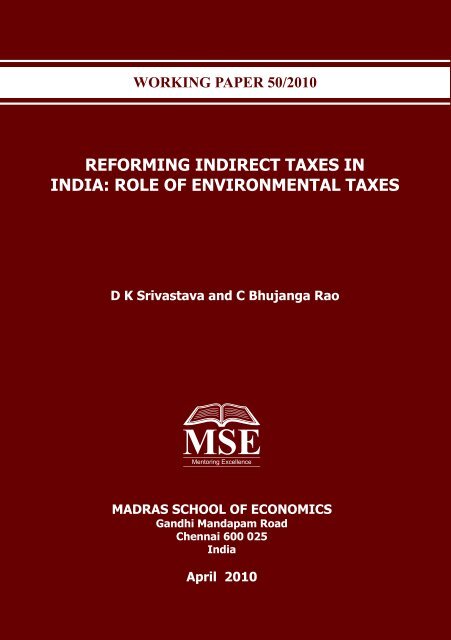
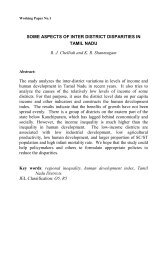
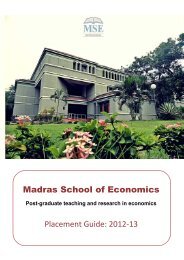
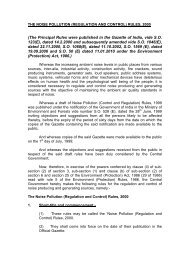
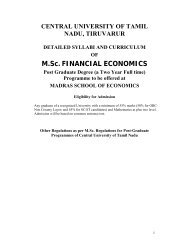
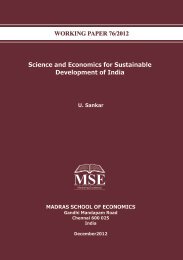
![Curriculum Vitae [pdf] - Madras School of Economics](https://img.yumpu.com/49878970/1/190x245/curriculum-vitae-pdf-madras-school-of-economics.jpg?quality=85)
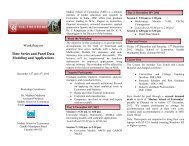
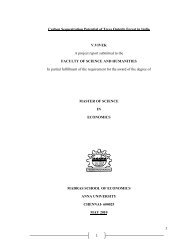
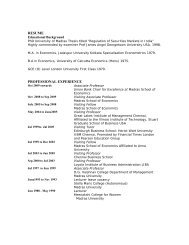
![Curriculum Vitae [pdf] - Madras School of Economics](https://img.yumpu.com/48715201/1/184x260/curriculum-vitae-pdf-madras-school-of-economics.jpg?quality=85)
